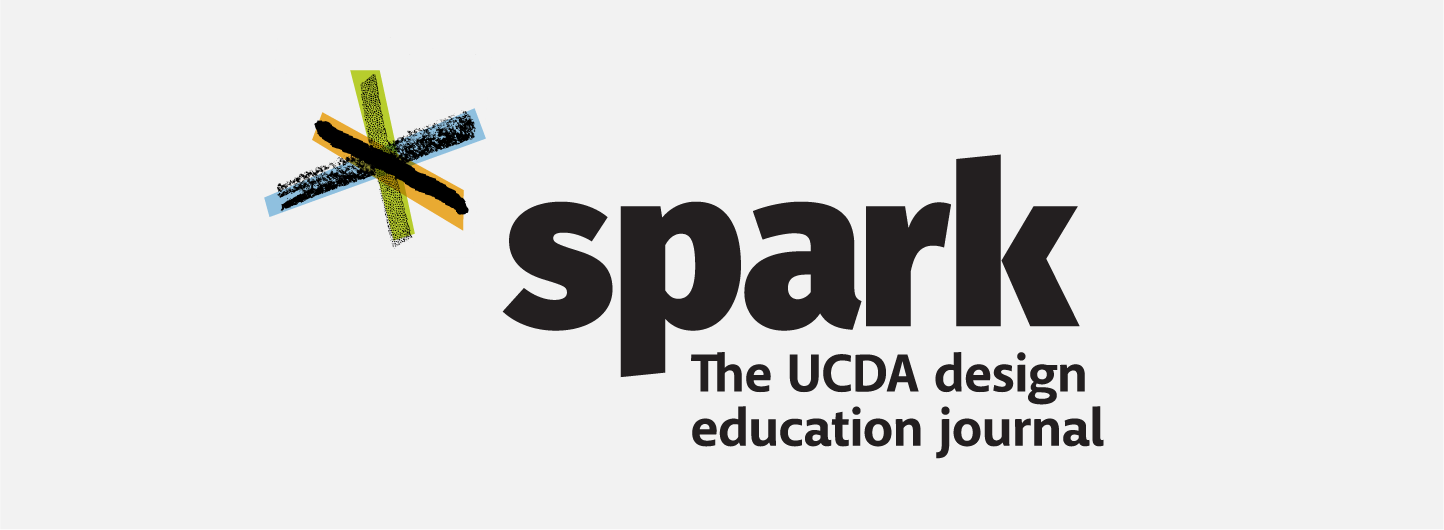
Spark – The UCDA Design Education Journal
CONTENTS
Jump to:
Submission Guidelines
Peer Review Process
Criteria for Peer Review
Author Services
SUBMISSION GUIDELINES
- Spark—the UCDA Design Edcuation Journal invites submissions that heighten and expand the understanding and practice of design and design education in the past, present, or future.
- Submissions must not have been previously published in print or online, although articles that expand research from previously published material are welcome.
- The only method of submission is by this form.
When submitting, you will be asked for the following:
- Your name*
- A biographical statement of 50–100 words
- Phone number
- Email address*
- Mailing address
- Current affiliation/institution*
- Job title/position*
- Title of Article
- A 250-word abstract of the article*
- Submission category* and secondary submission category (Categories include: General Design; Graphic Design; Interactive Design; Typography; UI/UX; Branding; Illustration; Design Foundations; Advertising/Marketing; Sustainable Design; Design Theory; Design Principles and Practices; Design Education; Design Thinking; Human-Centered Design; Design Activism; Professional Practices)
- Up to ten key words
When submitting, you will need to upload the following:
- A Microsoft Word ONLY, double-spaced typed manuscript set in 12 point Times New Roman with 1" margins, containing a maximum of 5,000 words (not including footnotes and captions), and images embedded within text, captioned and appropriately placed. Note: There is no preference in writing style (AP, Chicago, etc.); submit in the style you are most comfortable with.
- An illustration list (captions) with a maximum of 20 figures. Please note that each individual image file counts as one figure. Each caption must contain a title or brief description of the image including a credit line of the rights-holder.
- A separate .zip Image File containing web-resolution (72 dpi) numbered images (only jpeg, or png).
NOTE: Authors will be required to obtain and provide permissions to reprint any images, etc., for which they do not hold rights and should ensure the permissions will be obtainable if/when publication occurs.
PEER REVIEW PROCESS
Reviews for Spark—the UCDA Design Edcuation Journal are double-blind. Identities of the reviewer and author are concealed from each other. Double-blind reviews are considered of high-quality for tenure and promotion committees.
The will be reviewed initially by the Desk Review Committee and then by the select members of the Peer Review Committee.
Following peer-review, articles will either be accepted without change, accepted subject to minor or major revisions requested by committee, advised to rewrite and resubmit, or rejected.
In the case of publish with minor pr major revisions or revise and resubmit, the Editorial Board will provide guidance that could include a summary of review assessment or the review assessment in full.
Keep in mind that this process may be time consuming, so it may take some time for an article to be published following the initiation of the peer-review process.
CRITERIA FOR PEER REVIEW
- The originality of the manuscript’s position
- The clarity and completeness of the stated position (e.g., does the author(s) provide support from relevant literature?)
- The accessibility of the manuscript’s writing style
AUTHOR SERVICES
For those new to the journal process, here is a quick rundown of typial steps to help guide you.
Source: Taylor and Francis Author Services
1. Research your publishing options
Take the time to explore the journals in your field and to choose the best fit for your research. Although we welcome you to submit an article, Spark may not be the best journal for you. Find a journal that serves the audience you're trying to reach, and whose aims and scopr match your approach.
2. Draft your article
When you've chosen the journal you want to submit to, you're ready to start drafting your paper.
3. Instructions for authors
Follow the above guidelines and you'll know that the Spark editorial team have everything they need to conside your article for publication.
4. Make your submission
Your research is done, written your paper and are about to submit. Time for one final check to make sure you've got everything before heading to the journals submsiion form.
5. Peer review
If the chief editor thinks your article has potential for publication, they will send it out to be desk reviewed and peer reviewed by two or three expercts in the field. This can be a daunting process, but peer review is a fundamental part of getting published.
6. Making revisions
Following peer review, you may be asked to make revisions to your article and resubmit. Take time to read through the editor and reviewer's advice, and decide what changes you'll malke to your article. Taking their points on board will help ensure your final article is as impactful as possible.
7. Your article is accepted
The next step is producation and we will be working with the editorial team to get the article published in the online Spark journal.
8. Promoting your published work
Take time to let your colleagues know about your achievement. Congratulations.